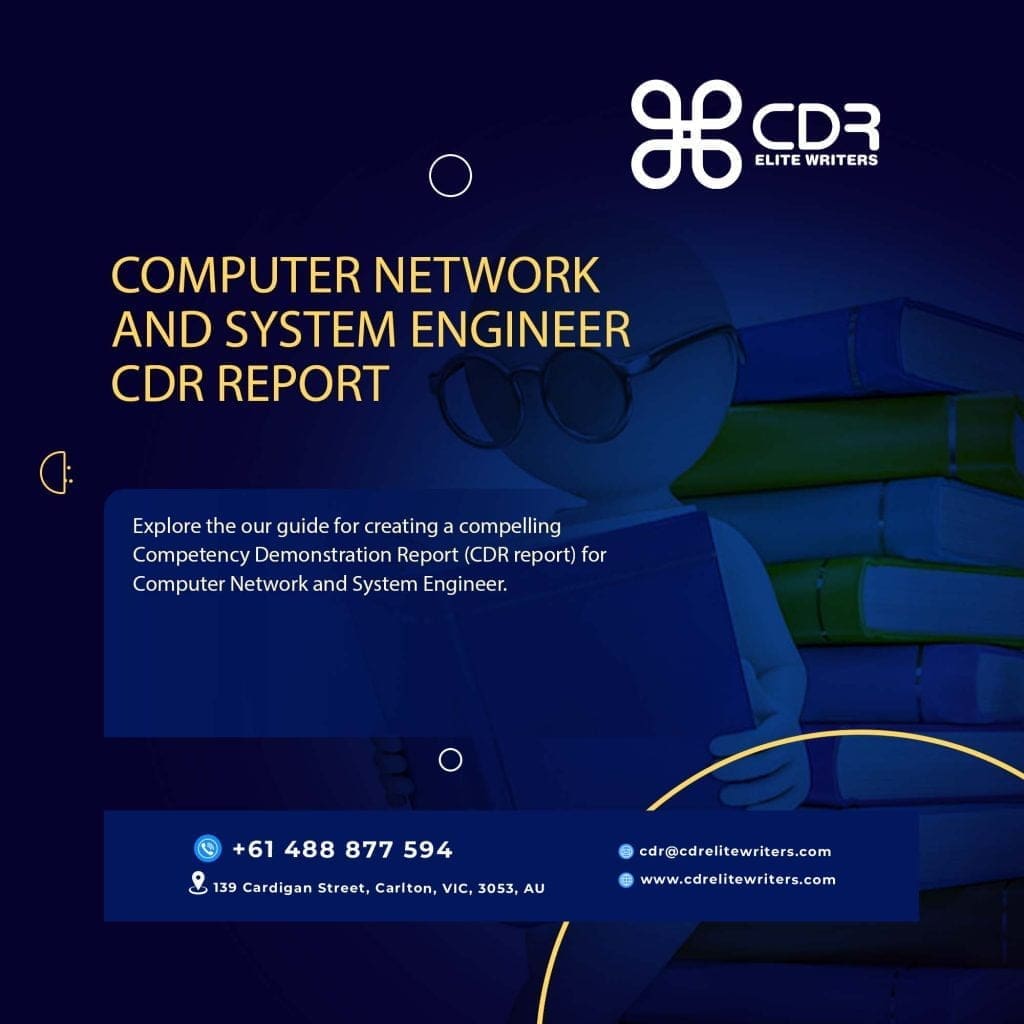Introduction
A Competency Demonstration Report (CDR Report) stands as a pivotal document for engineers desiring to establish their careers in countries like Australia, where the demand for skilled professionals in the field of computer network and system engineering is continually rising. The CDR Report not only showcases the competencies and achievements of an engineer but also acts as a testament to their ability to meet the stringent standards set by the engineering bodies governing practice in these nations.
It serves as a critical step in the migration skills assessment process, enabling engineers from around the globe to demonstrate their qualifications, work experience, and expertise in their specialized field, thereby opening the doorway to professional recognition and career advancement opportunities in a competitive and thriving job market.

Table of Contents
CDR Report Competencies for Computer Network and System Engineers
According to ANZSCO 26311, Computer Network and System Engineers research, analyze and recommend strategies for network architecture and development, implement, manage, maintain and configure network hardware and software, monitor and optimize performance, and troubleshoot and provide user support. Their tasks are as follows:
- Analyzing, developing, interpreting, and evaluating intricate system design and architecture specifications, data models, and diagrams are crucial in the process of developing, configuring, and integrating computer systems.
- Researching, analyzing, evaluating, and monitoring network infrastructure is crucial to ensure optimal network performance.
- Evaluating and suggesting enhancements for network operations, encompassing integrated hardware, software, communications, and operating systems.
- Offering specialized skills to support and troubleshoot network issues and emergencies.
- Installing, configuring, testing, maintaining, and administering new and upgraded networks, software, database applications, servers, and workstations.
- Offering network programming to meet distinct business needs and requirements.
- Developing and managing procedures and documentation for network inventory, documenting diagnosis and resolution of network issues, implementing network improvements and changes, and providing maintenance instructions.
- monitoring network traffic, and activity, capacity and usage to ensure continued integrity and optimal network performance
Skill Level
Most occupations in this unit group have a level of skill commensurate with a bachelor degree or higher qualification. At least five years of relevant experience and/or relevant vendor certification may substitute for the formal qualification. In some instances relevant experience and/or on-the-job training may be required in addition to the formal qualification (ANZSCO Skill Level 1).
According to a report from the Australian Bureau of Statistics on computer network and systems engineers, there are approximately 1400 employed professionals in this field. 44% of them have Bachelors degree as highest qualification.
Key Components of a Successful CDR Report

To successfully prepare a Competency Demonstration Report (CDR) for a Computer Network and System Engineer, it’s paramount to meticulously craft its three main sections: Continuous Professional Development (CPD), three Career Episodes, and the Summary Statement. These components collectively paint a comprehensive picture of an engineer’s capabilities, experiences, and ongoing commitment to professional growth.
Career Episodes
Summary of Career Episodes
A career episode is a detailed account of your engineering education or work experience, focusing on specific periods or aspects of your engineering activities. Each episode must highlight how you applied your engineering knowledge and skills in your nominated occupation.
Key Requirements
- Distinct Focus
Each career episode must cover a different period or aspect of your engineering experience.
- Evidence of Employment
Career episodes based on work experience must include proof of employment, such as a reference letter or certificate on official company letterhead. This should specify your title, employment dates, and be signed and dated.
- Possible Topics for Episodes
- An engineering task from your educational program.
- A project you have worked on or are currently involved in.
- A specific position you held or currently hold (beyond a simple duty statement).
- A particular engineering problem you solved.
- Writing Guidelines
- Each episode must be in English and written in your own words, showcasing your communication skills.
- Include reliable engineering evidence (diagrams, photos, calculations) to support your account, avoiding excessive textbook materials.
- Length should be between 1000 and 2500 words.
- Content Focus
- Clearly demonstrate the application of your engineering knowledge and skills, emphasizing your personal role (e.g., “I designed” or “I investigated”).
- Highlight engineering problems you identified and the problem-solving techniques you employed to achieve project objectives.
- Paragraph Numbering
Number each paragraph for clarity and to aid in constructing a Summary Statement. Use the following system:
- Career Episode 1: paragraphs 1.1, 1.2, 1.3, etc.
- Career Episode 2: paragraphs 2.1, 2.2, 2.3, etc.
By adhering to these guidelines, you can effectively document and showcase your engineering experiences in your career episodes.
Career Episode Format Explanation
Each career episode is a narrative that highlights your engineering experiences, presented in essay format without tables or image PDFs. Here’s how to structure your career episode effectively:
1. Introduction (Approx. 150 Words)
- Introduce the reader to your career episode.
- Provide context, including chronological details such as dates and duration of your experience.
- Mention the geographical location and the name of the organization you were associated with, setting the stage for your engineering activities.
2. Background (200-500 Words)
- Establish the context of your work or study.
- Describe the overall engineering project you were involved in, outlining its objectives and significance.
- Detail your specific work area within the project to clarify your role.
- Consider including an organizational structure chart for visual clarity.
- If available, provide a statement of your duties to highlight your responsibilities and contributions.
3. Personal Engineering Activity (600-1500 Words)
- This section is the core of your career episode and crucial for assessment.
- Describe in detail the work you performed, emphasizing your individual contributions rather than team activities.
- Highlight the engineering competencies you applied, the tasks assigned to you, technical challenges encountered, and solutions devised.
- Include any original or creative design work initiated and how you collaborated with team members to achieve project goals, showcasing your problem-solving skills and engineering knowledge.
4. Summary (50-150 Words)
- Reflect on the engineering activity and your involvement.
- Share your overall impressions of the project, discussing its alignment with goals and requirements.
- Highlight how your contributions impacted the project’s success, encapsulating your experience and the value you brought to the engineering endeavor.
Ensure each Career Episode adheres to Engineer Australia’s competency elements and directly correlates your experiences with the competencies they’re looking for. This targeted approach can significantly enhance the effectiveness of your Competency Demonstration Report.
CDR Summary Statement
The CDR Summary Statement presents a concise yet comprehensive mapping of the competencies demonstrated in the Career Episodes against the competency elements required for the Computer Network and System Engineer category. It requires the engineer to analyze thoroughly and present a cross-reference to the relevant paragraphs of the Career Episodes where each competency is addressed. This document serves as an executive summary, allowing assessors to quickly identify the applicant’s competencies and their substantiation throughout the Career Episodes.
After completing your career episodes, it’s essential to analyze them to ensure all competency elements for your nominated occupational category are addressed. The results of this analysis will be reflected in your Summary Statement, which cross-references the competency elements with the specific paragraphs in your Career Episodes where each element is mentioned. To facilitate this, be sure to number the paragraphs in your career episodes. You’ll also need to download and complete the appropriate Summary Statement for your chosen occupational category; templates are available on the website as a guide. Keep in mind that your Summary Statement does not need to be confined to a single page, and you are not required to cover every indicator within each competency element.
Note: A single Summary Statement suffices for all three episodes.
Continuing Professional Development (CPD)

The Continuing Professional Development (CPD) aims to demonstrate the engineer’s unceasing efforts to stay current in the rapidly evolving field of computer network and system engineering. It should encapsulate all the post-graduation activities undertaken by the applicant to maintain, improve, and broaden their knowledge, skills, and personal qualities necessary for the execution of professional and technical duties. These activities can range from attending workshops, conferences, and seminars to self-study of relevant literature, participation in professional bodies, and undertaking private studies such as reading books or journals relevant to the field.
To construct an effective CPD for a Computer Network and System Engineer CDR Report, the following components should be meticulously detailed:
- Formal Education and Training: List any post-graduate degrees, diplomas, certifications, or specialized training undertaken in the field of computer network and system engineering.
- Workshops, Seminars, and Conferences: Detail participation in workshops, seminars, conferences, webinars, or any other professional gatherings that contribute to professional knowledge and skill enhancement.
- Professional Practice: Mention any active involvement in professional engineering bodies or communities, including any volunteering activities related to the field.
- Private Studies: Include self-led learning initiatives, such as reading technical books, journals, research papers, or engaging with online courses and tutorials relevant to computer network and system engineering.
- Publications and Research: Highlight any contributions to professional journals, blogs, or conferences, including research projects or papers on relevant topics within the field.
- Technical Skills Development: Detail any specific software, tools, or technologies learned and mastered which are directly related to computer network and system engineering.
Sample Project Topics Ideas for CDR Report for Computer Network and System Engineers
When choosing Projects for your Career Episodes as you write your cdr report for engineers australia, it’s crucial to select projects or tasks that clearly demonstrate your engineering ability, problem-solving skills, and contribution to significant outcomes. Here are some suggested topics relevant to Computer Network and System Engineering:
- Design and Implementation of Network Infrastructure: Outline a project where you designed or upgraded a network infrastructure, including hardware and software choices, to improve efficiency, reliability, or security. Focus on the rationale behind architectural decisions and the challenges faced during the implementation.
- Cybersecurity Solutions Development: Narrate your involvement in developing or implementing cybersecurity measures to protect organizational data. Highlight your approach to assessing risks, choosing appropriate security protocols, and the results of these implementations in enhancing system security.
- Cloud Computing Projects: Discuss a scenario where you led or played a significant role in migrating traditional systems to cloud-based solutions. Concentrate on the strategic planning, selection of cloud services, and the benefits realized by the organization after migration, such as cost savings or improved scalability.
- Automation and Optimization of Network Processes: Share insights into a project where you automated routine network maintenance tasks or optimized existing network processes. Describe the technologies used, such as AI or machine learning algorithms, and the impact on operational efficiency.
- Software-Defined Networking (SDN) Implementation: Describe your experience in implementing SDN within an organization. Explain the transition from a traditional network model to SDN, highlighting the technical challenges, the solutions devised, and the overall impact on network management and flexibility.
Skills Assessment Application procedures
The process of migrating to Australia, particularly for skilled professionals like engineers, involves a series of steps designed to assess the applicant’s qualifications, skills, and suitability for the Australian job market. Below is an outline of the procedural steps from beginning to end:

- Skills Assessment: Begin by preparing your Competency Demonstration Report (CDR Report) for submission to Engineers Australia or the relevant assessing authority for your profession. This report should detail your engineering education, work experience, and competencies.
- English Language Proficiency Test: Take an English language proficiency test such as IELTS, TOEFL, or PTE Academic if English is not your first language. Attain the required score as per the guidelines of the Department of Home Affairs.
- Submit an Expression of Interest (EOI): Through Skill Select, submit an EOI indicating your desire to migrate to Australia. This online application requires details about your skills, qualifications, and nominated occupation.
- Receive an Invitation to Apply (ITA): Based on your EOI, you may receive an ITA for a skilled visa. The selection criteria include points for age, English language ability, skilled employment experience, and educational qualifications.
- Visa Application: After receiving an ITA, formally apply for a skilled visa. This involves submitting a visa application along with all required documents, including the positive skills assessment, English proficiency test results, and other supporting documents.
- Health Examination and Police Verification: Undergo a health examination and provide police clearance certificates from each country you’ve lived in for 12 months or more, over the last ten years, to prove you meet the character requirements.
- Visa Decision: Wait for the decision on your visa application. This step may take several months, depending on the visa category and individual circumstances.
- Prepare for the Move: Once your visa is granted, start preparing for your move to Australia. This includes arranging for housing, schooling for children if applicable, and understanding your rights and responsibilities as a new migrant.
- Arrival in Australia: Upon arrival, attend an initial orientation session if available, which may be offered by some states or territories to help new migrants settle in.
- Apply for Jobs: Begin applying for jobs in your field. Leverage local job searching platforms, networking opportunities, and professional associations relevant to your profession.
- Continual Professional Development: Once employed, look into further education or professional development opportunities to enhance your career prospects and fulfill any continuing professional development requirements set by your professional body in Australia.
By methodically following these steps, skilled professionals can maximize their chances of successfully migrating and establishing a fulfilling career in Australia.
Conclusion
Crafting a compelling Competency Demonstration Report (CDR Report) is a critical step in affirming your engineering skills and knowledge to the Australian engineering bodies. By strategically highlighting your professional experiences, skills, and achievements in a clear, concise, and technical manner, you set the foundation for a successful assessment. Remember, the goal is not just to list your capabilities but to demonstrate them through well-chosen Career Episodes that reflect real-world problem-solving, innovation, and leadership. Your CDR Report can become a powerful testament to your proficiency and a pivotal step towards reaching your career aspirations in Australia.
Frequently Asked Questions
u003cstrongu003eu003cstrongu003eWhat skills are essential for a Computer Network and Systems Engineer?u003c/strongu003eu003c/strongu003e
Key skills include proficiency in network protocols (such as TCP/IP, DNS, and DHCP), experience with firewall and security configurations, knowledge of network monitoring tools, and strong problem-solving abilities.
u003cstrongu003eu003cstrongu003eWhat is the primary role of a Computer Network and Systems Engineer?u003c/strongu003eu003c/strongu003e
A Computer Network and Systems Engineer is responsible for designing, implementing, and maintaining an organization’s network infrastructure and computer systems to ensure seamless connectivity and data exchange.
u003cstrongu003eu003cstrongu003eWhat are the most common mistakes applicants make in their CDR Report? u003c/strongu003eu003c/strongu003e
Common mistakes include being too vague in career episodes, failing to link skills with the required competencies, not providing sufficient evidence of engineering experience, and not adhering to the prescribed format.
Can I include online courses in my CPD activities?
Yes, online courses, especially those that offer advanced knowledge and skills in electrical engineering, are a valid part of your Continuing Professional Development activities. It is beneficial to include courses accredited by professional bodies or reputable institutions.u003cbru003e



